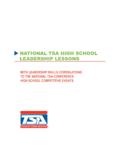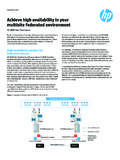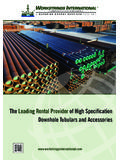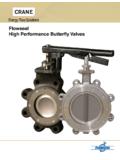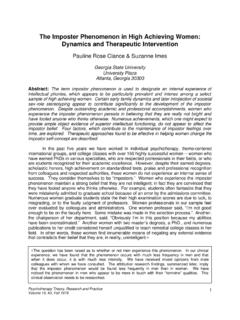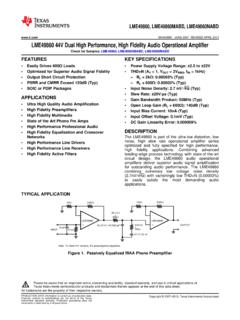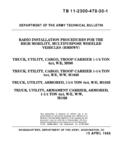Transcription of High-Voltage, High-Current Operational Amplifier …
1 OPA549 high -Voltage, high -CurrentOPERATIONAL AMPLIFIERDESCRIPTIONThe OPA549 is a low-cost, high -voltage/ High-Current opera - tional Amplifier ideal for driving a wide variety of loads. Thislaser-trimmed monolithic integrated circuit provides excellentlow-level signal accuracy and high output voltage and OPA549 operates from either single or dual supplies fordesign flexibility. The input common-mode range extendsbelow the negative OPA549 is internally protected against over-temperatureconditions and current overloads. In addition, the OPA549provides an accurate, user-selected current limit. Unlikeother designs which use a power resistor in series with theoutput current path, the OPA549 senses the load allows the current limit to be adjusted from 0A to 10 Awith a resistor/potentiometer, or controlled digitally with avoltage-out or current-out Digital-to-Analog Converter (DAC).
2 The Enable/Status (E/S) pin provides two functions. It can bemonitored to determine if the device is in thermal shutdown,and it can be forced low to disable the output stage andeffectively disconnect the OPA549 is available in an 11-lead power package. Itscopper tab allows easy mounting to a heat sink for excellentthermal performance. Operation is specified over the ex-tended industrial temperature range, 40 C to +85 high OUTPUT CURRENT:8A Continuous10A Peak WIDE POWER-SUPPLY RANGE:Single Supply: +8V to +60 VDual Supply: 4V to 30V WIDE OUTPUT VOLTAGE SWING FULLY PROTECTED:Thermal ShutdownAdjustable Current Limit OUTPUT DISABLE CONTROL THERMAL SHUTDOWN INDICATOR high SLEW RATE: 9V/ s CONTROL REFERENCE PIN 11-LEAD POWER PACKAGEAPPLICATIONS VALVE, ACTUATOR DRIVERS SYNCHRO, SERVO DRIVERS POWER SUPPLIES TEST EQUIPMENT TRANSDUCER EXCITATION AUDIO POWER AMPLIFIERSOPA549V+E/SRCLRCL sets the current limitvalue from 0A to 10A.
3 (Very Low Power Dissipation)ILIMVOV RefES PinForced Low: Output Low: Thermal DATA information is current as of publication conform to specifications per the terms of Texas Instrumentsstandard warranty. Production processing does not necessarily includetesting of all 1999-2005, Texas Instruments IncorporatedPlease be aware that an important notice concerning availability, standard warranty, and use in critical applications ofTexas Instruments semiconductor products and disclaimers thereto appears at the end of this data MARCH 1999 REVISED OCTOBER 2005 All trademarks are the property of their respective Current .. See SOA Curve (Figure 6)Supply Voltage, V+ to V .. 60 VInput Voltage Range .. (V ) to (V+) + Shutdown Voltage.
4 Ref to V+Operating Temperature .. 40 C to +125 CStorage Temperature .. 55 C to +125 CJunction Temperature .. 150 CLead Temperature (soldering, 10s) .. 300 CESD Capability (Human Body Model) .. 2000 VNOTE: (1) Stresses above these ratings may cause permanent to absolute maximum conditions for extended periods may de-grade device DIAGRAM In+InRefILIME/SV+VO1357911246810V Tab connected to V . Do not use to conduct both pins 1 and 2 to both pins 5 and 7 to V .Connect both pins 10 and 11 to V+.ABSOLUTE MAXIMUM RATINGS(1)For the most current package and ordering information, seethe Package Option Addendum at the end of this datasheetor see the TI website at INFORMATIONELECTROSTATICDISCHARGE SENSITIVITYThis integrated circuit can be damaged by ESD.
5 Texas Instru-ments recommends that all integrated circuits be handled withappropriate precautions. Failure to observe proper handlingand installation procedures can cause damage can range from subtle performance degradationto complete device failure. Precision integrated circuits may bemore susceptible to damage because very small parametricchanges could cause the device not to meet its CHARACTERISTICSB oldface limits apply over the specified temperature range, TA = 40 C to +85 TCASE = +25 C, VS = 30V, Ref = 0V, and E/S pin open, unless otherwise , SPARAMETERCONDITIONMINTYPMAXUNITSOFFSET VOLTAGEVOSI nput Offset VoltageVCM = 0V, IO = 0 1 5mVvs TemperaturedVOS/dTTCASE = 40 C to +85 C 20 V/ Cvs Power SupplyPSRRVS = 4V to 30V, Ref = V 25100 V/VINPUT BIAS CURRENT(1)Input Bias Current(2)
6 IBVCM = 0V 100 500nAvs TemperatureTCASE = 40 C to +85 C CInput Offset CurrentIOSVCM = 0V 5 50nANOISEI nput Voltage Noise Densityenf = 1kHz70nV/ HzCurrent Noise Densityinf = 1kHz1pA/ HzINPUT VOLTAGE RANGEC ommon-Mode Voltage Range: PositiveVCML inear Operation(V+) 3(V+) Operation(V ) (V ) Rejection RatioCMRRVCM = (V ) to (V+) 3V8095dBINPUT IMPEDANCED ifferential107 || 6 || pFCommon-Mode109 || 4 || pFOPEN-LOOP GAINOpen-Loop Voltage GainAOLVO = 25V, RL = 1k 100110dBVO = 25V, RL = 4 100dBFREQUENCY RESPONSEGain Bandwidth RateSRG = 1, 50Vp-p Step, RL = 4 9V/ sFull-Power BandwidthSee Typical CurveSettling Time: = 10, 50V Step20 sTotal Harmonic Distortion + Noise(3)THD+Nf = 1kHz,RL = 4 ,G = +3, Power = Output, PositiveIO = 2A(V+) (V+) = 2A(V ) + (V ) + = 8A(V+) (V+) = 8A(V ) + (V ) + = 8 to V (V ) + (V ) + Continuous Current Output.
7 Dc(4) 8 Aac(4)Waveform Cannot Exceed 10A peak8A rmsOutput Current LimitCurrent Limit Range0 to 10 ACurrent Limit EquationILIM = 15800 (7500 + RCL)ACurrent Limit Tolerance(1)RCL = (ILIM = 5A), RL = 4 200 500mACapacitive Load Drive (Stable Operation) CLOADSee Typical CurveOutput DisabledLeakage CurrentOutput Disabled, VO = 0V 2000 200+2000 AOutput CapacitanceOutput Disabled750pFOUTPUT ENABLE/STATUS (E/S) PINS hutdown Input ModeVE/S high (output enabled)E/S Pin Open or Forced high (Ref) + Low (output disabled)E/S Pin Forced Low(Ref) + high (output enabled)E/S Pin Indicates high 50 AIE/S Low (output disabled)E/S Pin Indicates Low 55 AOutput Disable Time1 sOutput Enable Time3 sThermal Shutdown Status OutputNormal OperationSourcing 20 A(Ref) + (Ref) + ShutdownSinking 5 A, TJ > 160 C(Ref) + (Ref) + Temperature, Shutdown+160 CReset from Shutdown+140 CRef (Reference Pin for Control Signals)Voltage RangeV (V+) 8 VCurrent(2) SUPPLYS pecified VoltageVS 30 VOperating Voltage Range, (V+) (V )860 VQuiescent CurrentIQILIM Connected to Ref IO = 0 26 35mAQuiescent Current in Shutdown ModeILIM Connected to Ref 6mATEMPERATURE RANGES pecified Range 40+85 COperating Range 40+125 CStorage Range 55+125 CThermal Resistance, C/WThermal Resistance, JANo Heat Sink30 C/WNOTES: (1) high -speed test at TJ = +25 C.
8 (2) Positive conventional current is defined as flowing into the terminal. (3) See Total Harmonic Distortion + Noise vsFrequency in the Typical Characteristics section for additional power levels. (4) See Safe Operating Area (SOA) in the Typical Characteristics CHARACTERISTICSAt TCASE = +25 C, VS = 30V, and E/S pin open, unless otherwise noted. 60 40 20020406080140120100 130 120 110 100 90 80 70 60 50 40 Input Bias Current (nA)Temperature ( C)INPUT BIAS CURRENT vs TEMPERATURE IB+IB 30 20 100 102030 200 180 160 140 120 100 80 60 40 20 0 Input Bias Current (nA)Common-Mode Voltage (V)INPUT BIAS CURRENTvs COMMON-MODE VOLTAGE1101001k10k100k1M10M1201008060402 00 20 400 20 40 60 80 100 120 140 160 Gain (dB)Phase ( )Frequency (Hz)OPEN-LOOP GAIN AND PHASEvs FREQUENCY0510152025309876543210 Current Limit (A)Supply Voltage (V)CURRENT LIMIT vs SUPPLY VOLTAGE+ILIM, 5A ILIM, 5A+ILIM, 2A ILIM, 2A+ILIM, 8A ILIM, 8A 75 50 250255075100125302520151050 Quiescent Current (mA)Temperature ( C)QUIESCENT CURRENT vs TEMPERATUREVS = 30 VVS = 5 VIQ Shutdown (output disabled)
9 75 50 2502550751001259876543210 Current Limit (A)Temperature ( C)CURRENT LIMIT vs CHARACTERISTICS (Cont.)At TCASE = +25 C, VS = 30V, and E/S pin open, unless otherwise Noise (nV/ Hz)Frequency (Hz)VOLTAGE NOISE DENSITY vs FREQUENCY101001k10k100k1M120100806040200 Power-Supply Rejection Ratio (dB)Frequency (Hz)POWER-SUPPLY REJECTION RATIOvs FREQUENCY PSRR+PSRR 75 50050100 AOL1251201101009080 AOL, CMRR, PSRR (dB)Temperature ( C)OPEN-LOOP GAIN, COMMON-MODE REJECTION RATIO,AND POWER-SUPPLY REJECTION RATIO vs TEMPERATURECMRRPSRR201001k10k +N (%)Frequency (Hz)TOTAL HARMONIC DISTORTION + NOISEvs FREQUENCYG = +3RL = 4 75 50 Product (MHz)Slew Rate (V/ s)Temperature ( C)GAIN-BANDWIDTH PRODUCT ANDSLEW RATE vs TEMPERATURESR+SR GBW101001k10k100k100908070605040 Common-Mode Rejection (dB)Frequency (Hz)COMMON-MODE REJECTION RATIO vs CHARACTERISTICS (Cont.)
10 At TCASE = +25 C, VS = 30V, and E/S pin open, unless otherwise VSUPPLY VOUT (V)Temperature ( C)OUTPUT VOLTAGE SWING vs TEMPERATURE 75 50 250255075100125IO = +8 AIO = 8 AIO = +2 AIO = 2A1k10k100k1M302520151050 Output Voltage (Vp)Frequency (Hz)MAXIMUM OUTPUT VOLTAGE SWINGvs FREQUENCYM aximum outputvoltage withoutslew VSUPPLY VOUT (V)Output Current (A)OUTPUT VOLTAGE SWING vs OUTPUT CURRENT(V+) VO (V ) VO 40 30 20 10010204030543210 1 2 3 4 5 Leakage Current (mA)Output Voltage (V)OUTPUT LEAKAGE CURRENTvs APPLIED OUTPUT VOLTAGERCL = RCL = 0 Leakage current with output VOLTAGEPRODUCTION DISTRIBUTIONP ercent of Amplifiers (%)Offset Voltage (mV) VOLTAGE DRIFTPRODUCTION DISTRIBUTIONP ercent of Amplifiers (%)Offset Voltage ( V/ C) CHARACTERISTICS (Cont.)











